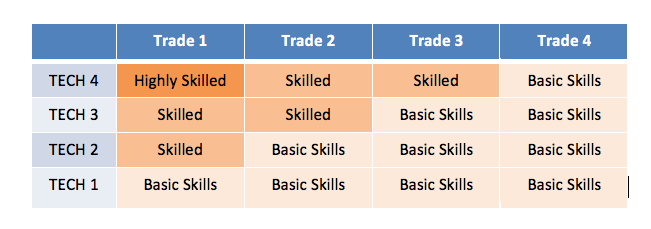« Return to FMDAA entries

Pasco County, Port Richey, Fla.
Overview
The Pasco County facilities management department, like many local government branches, faces many challenges. One of those challenges is employee retention. Trade workers are no exception to that rule. Employees of local government organizations are easily swayed by large companies and the promise of promotion. The private sector offers a higher pay scale and a greater chance for advancement. Although the county offers a decent benefit package, its pay scale and chance for advancements were limited. The only way that a trade worker could advance is if a coworker retired, found work elsewhere or passed away. This employee classification and current pay structure did not allow for advancement. Here was the challenge — how do we change the culture and structure that had been part of this county for decades? It wasn’t easy. It involved the buy-in of the whole department, the acceptance from human resources, approval from the county administrator and the permission of the Pasco County Board of County Commissioners.
In 2009, the Facilities Management Department reorganized. This reorganization saw the conversion of the various trades’ positions (carpenter, electrician, HVAC tech, and plumber) consolidated into a universal position called maintenance technician.
The Pasco County facilities management operations and maintenance division has made noteworthy efforts in establishing a skills-based evaluation system that enables maintenance technicians to be evaluated fairly and consistently for each of the four main trade categories (electrical, plumbing, HVAC, and carpentry/general construction) to determine the individual’s level of skill within each of those categories. Skills assessments will be linked to the skill levels required for the maintenance technician pay levels (1-4), and promotions will be granted upon assessment and determination of all the skill levels.
The maintenance technician classifications are broken down into four levels as seen in the chart below.
The skills-based promotions would qualify personnel with the requisite knowledge, skills, and abilities to automatically advance to their proper maintenance technician classification. This classification was conducted by management with an interview with the employee and his immediate supervisor. This resulted in the determination of the proper classification of each maintenance technician. This also allowed the facility team to evaluate their overall department’s strengths and weaknesses. Now with the proper classification of each technician, we were ready to start the skilled-based promotion program, which was the entire basis for this long process.
The actual program took on a whole new set of challenges. Can we fund any or all of the promotions? Will human resources agree that this is a fair and equitable program? Is the county administrator on board and finally? Will the team buy in? The realization that this program was so close but yet still so far off was daunting. Although it seemed impossible to meet those challenges, persistence paid off.
The program is composed of two parts — a training element and an evaluation element. The first element of the program is the training system that is directly aligned to enable individuals to study at their own pace to gain the skills necessary to apply for the evaluation interview. This training system is comprised of a number of modules on each trade. These modules can be used by all the technicians to enhance and expand their knowledge of a chosen trade.
The second element is the evaluation element. The maintenance technician who believes they are skilled or highly skilled in a trade would notify their supervisor that they wish to be evaluated. The supervisor will ensure that a sufficient amount of hands on experience has been completed in the trade category based on the work order completion criteria found in our CMMS. An evaluation interview would be conducted by an evaluation board of three teammates who are already skilled or highly skilled in that trade. The evaluation board is selected by the facilities operations and maintenance tanager.
The evaluation board will assess the maintenance technician’s knowledge of a particular trade using a skills questionnaire. The technician will have the opportunity to verbally define, describe, or explain how they would address each evaluation question. The technicians that were able to score 80 percent on the evaluation would be considered skilled and those that scored 90% and above would be considered highly skilled. The evaluation consisted of highly skilled, skilled, and basic skilled questions. A number of basic skills questions were asked in each evaluation. If any of the basic skills questions were not answered satisfactorily. The technician would not pass the evaluation regardless of the percentage score. Once a technician has been evaluated and dependent on their skill level, they would automatically move to the appropriate Tech level and pay range.
To date, we have had 16 technicians advance their skill level and receive pay increases, some with multiple pay increases. This was the result of some hard-fought battles of a couple of team members over the years. One of them has become our facilities director.
This program has been a big plus for the facilities management department. It has created the opportunity for advancement, allowed the facility team to expand their knowledge and continue to grow as a team. The team has also been able to supply their customers with an overall more productive approach to repairs. The technicians having multiple skill levels and a non-specific trade orientation has increased overall production exponentially.
In-House Participants
Andrew Baxter, Erik Breitenbach, Jesse Bednarik, TJ Pyche, Dan Corson 
↑ Back to top









